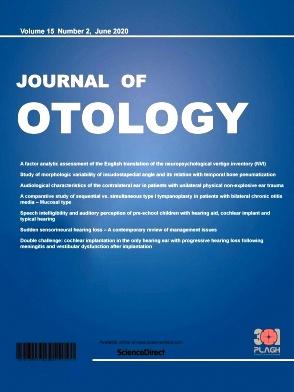建立听障儿童人工耳蜗植入效果量化评估系统
IF 1.4
Q2 OTORHINOLARYNGOLOGY
引用次数: 0
摘要
人工耳蜗是目前最广泛证实的用于重度感音神经性听力障碍儿童听觉康复的干预措施。然而,目前这些评价方法存在明显的局限性。本研究旨在建立一个定量评估听力受损儿童人工耳蜗植入效果的评估系统。方法根据评价儿童人工耳蜗效果的相关文献,建立初步指标体系,编制相应的问卷调查。来自中国9个省份的25位耳科、临床听力学、康复听力学和心理健康专家进行了咨询。分析了专家的权威性和协调性以及定量评价体系的指标和权重。从湖北省两个中心招募了78名3-11岁的人工耳蜗植入术后儿童,对定量评价体系进行信度和效度评价。结果经过第二轮通信,专家意见趋于一致,专家共识的协调性和权威性得到满足。两轮问卷的召回率均为100%。听力、语言、行为、学习、生活质量等5个二级指标和13个三级指标用于人工耳蜗植入效果的评价。计算各指标的权重。基于标准化项目的定量评价体系的Cronbach’s α系数为0.930,提取的3个公因子可解释总方差的78.86%。结论建立了一套基于专家共识的儿童人工耳蜗植入效果定量评价体系,具有良好的信度和效度。本文章由计算机程序翻译,如有差异,请以英文原文为准。
Establishment of quantitative evaluation system for cochlear implant effectiveness for hearing-impaired children
Introduction
Cochlear implant is currently the most widely proven interventions for auditory rehabilitation for children with severe sensorineural hearing impairment. However, there are obvious limitations in these current evaluation methods. This study aims to develop an evaluation system for quantitatively evaluating the effectiveness of cochlear implants for hearing-impaired children.
Methods
A correspondence questionnaire was developed based on an initial indicator system that was developed based on the literature focused on the evaluation of cochlear implant outcomes in children. Twenty-five experts in otology, clinical audiology, rehabilitation audiology, and mental health from nine provinces in China were consulted. The degree of authority and coordination of experts and the indicators and weights of the quantitative evaluation system were analyzed. Seventy-eight children aged 3–11 years after cochlear implantation were recruited from two centers in Hubei province to evaluate the reliability and validity of the quantitative evaluation system.
Results
The opinions of experts converged after the second round of correspondence, and the coordination and authority of the expert consensus were met. The recall rate of the questionnaire was 100% for both rounds. Five secondary indicators, including auditory ability, verbal ability, behavioral assessment, learning capabilities, and quality of life, and 13 tertiary indicators were reserved for the evaluation of cochlear implant effectiveness. The weight of each indicator was calculated. The Cronbach’s α coefficient of the quantitative evaluation system based on the standardized items was 0.930, and the three extracted common factors could explain 78.86% of the total variance.
Conclusions
An expert consensus-based evaluation system that can quantitatively evaluate the effectiveness of cochlear implants in children has been developed with good reliability and validity.
求助全文
通过发布文献求助,成功后即可免费获取论文全文。
去求助
来源期刊

Journal of Otology
Medicine-Otorhinolaryngology
CiteScore
2.70
自引率
0.00%
发文量
461
审稿时长
18 days
期刊介绍:
Journal of Otology is an open access, peer-reviewed journal that publishes research findings from disciplines related to both clinical and basic science aspects of auditory and vestibular system and diseases of the ear. This journal welcomes submissions describing original experimental research that may improve our understanding of the mechanisms underlying problems of basic or clinical significance and treatment of patients with disorders of the auditory and vestibular systems. In addition to original papers the journal also offers invited review articles on current topics written by leading experts in the field. The journal is of primary importance for all scientists and practitioners interested in audiology, otology and neurotology, auditory neurosciences and related disciplines. Journal of Otology welcomes contributions from scholars in all countries and regions across the world.
 求助内容:
求助内容: 应助结果提醒方式:
应助结果提醒方式:


